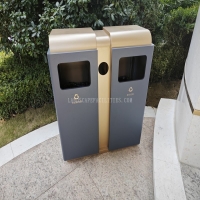Welcome to the website for landscape facilities products and knowledge.
How does the table perform in terms of UV resistance if used outdoors for extended periods?
When considering outdoor furniture for long-term use, UV resistance becomes a critical factor in determining durability and appearance retention. Tables designed for exterior environments undergo significant challenges from continuous sun exposure, making their UV performance a key consideration for consumers and designers alike.
The fundamental mechanism behind UV degradation involves photochemical reactions where ultraviolet radiation breaks down chemical bonds in materials. This process manifests as color fading, surface chalking, and reduced structural integrity over time. High-quality outdoor tables incorporate advanced UV inhibitors directly into their material composition, creating inherent protection that doesn't wash or wear away.
Material selection plays a pivotal role in UV performance. High-density polyethylene (HDPE) demonstrates exceptional UV stability due to its molecular structure, while powder-coated aluminum provides both physical and chemical barriers against ultraviolet rays. Tropical hardwoods like teak contain natural oils that offer inherent UV protection, though they require periodic maintenance to preserve this characteristic.
Manufacturing techniques significantly enhance UV resistance. Co-extrusion processes create a protective outer layer that shields against ultraviolet penetration, while UV-absorbing additives integrated during production create permanent protection throughout the material thickness. The effectiveness of these treatments varies by manufacturer, with premium products typically offering 5-10 years of guaranteed UV protection without significant degradation.
Environmental factors interact with UV exposure to accelerate or mitigate damage. Tables in coastal environments face combined challenges from UV radiation and salt air, while high-altitude locations experience more intense ultraviolet exposure. Proper placement considering shade patterns and seasonal sun angles can substantially extend a table's service life.
Maintenance practices directly impact long-term UV performance. Regular cleaning removes contaminants that can accelerate UV damage, while protective sealants replenish surface barriers against ultraviolet penetration. For plastic tables, specialized UV-protectant sprays can restore faded surfaces and provide additional shielding.
Performance testing standards help consumers evaluate UV resistance claims. Look for tables tested according to ASTM G154 or similar standards, which simulate extended outdoor exposure. Tables rated for commercial use typically undergo more rigorous testing than residential-grade products, ensuring better long-term performance in high-usage environments.
The economic consideration of UV-resistant tables involves calculating long-term value rather than initial cost. While premium UV-protected tables command higher prices, their extended service life and maintained appearance often justify the investment compared to frequently replacing inferior products.
Innovations in UV protection continue to evolve, with nanotechnology creating more effective and environmentally friendly solutions. New composite materials combine UV resistance with other desirable properties like mold resistance and impact strength, creating multifunctional outdoor tables capable of withstanding diverse environmental challenges.
Understanding these factors enables informed decisions when selecting outdoor tables, ensuring optimal performance throughout their intended service life while maintaining aesthetic appeal despite continuous sun exposure.
Related search:

Recommendation
Double-bucket garbage bin, outdoor, metal, multi-color, powder-coated, double-bucket trash can